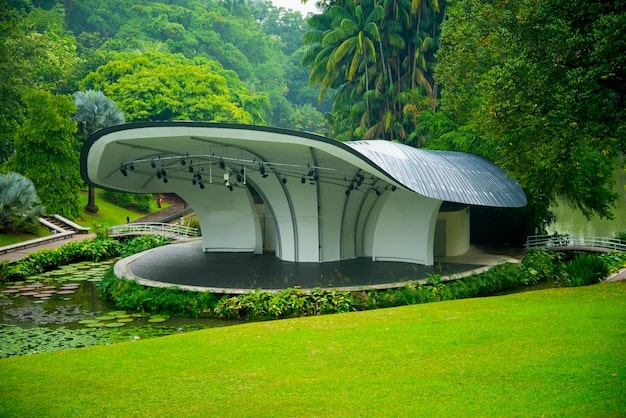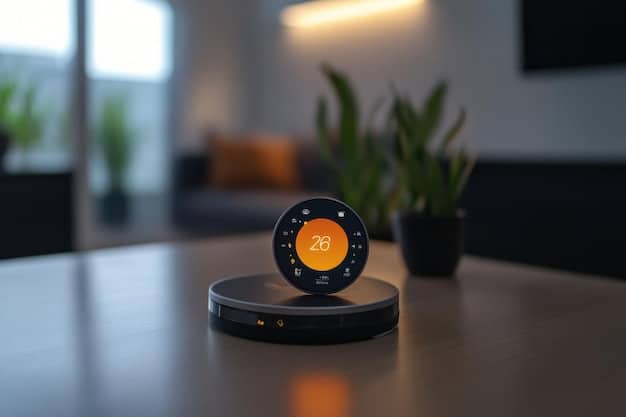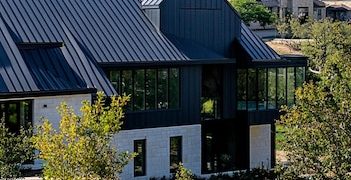Mastering Home Energy Efficiency: A Comprehensive Guide

Achieving home energy efficiency involves integrating smart technologies, insulation, and behavioral changes to significantly reduce utility bills and environmental impact.
In today’s world, understanding home energy efficiency is more crucial than ever. It’s not just about saving money on utility bills, but also about making a positive impact on the environment. This guide aims to provide a comprehensive look at how you can transform your home into an energy-efficient haven.
Understanding the Basics of Energy Consumption at Home
To embark on a journey towards home energy efficiency, it is fundamental to first grasp where and how energy is consumed within your living space. This initial understanding illuminates the primary culprits of high energy bills and guides effective intervention strategies.
Often, a significant portion of household energy is allocated to heating and cooling. These systems, while essential for comfort, can be remarkably inefficient if not properly maintained or updated. Appliances also contribute substantially, with some consuming energy even when not actively in use—a phenomenon known as “phantom load.”
Key Areas of Energy Use
Identifying specific areas of high energy consumption is the first step toward optimization. This involves a careful assessment of your home’s structure and the habits of its occupants.
- Building Envelope: This includes walls, roof, windows, and doors—components critical for retaining heat in winter and coolness in summer.
- HVAC Systems: Heating, Ventilation, and Air Conditioning units are typically the largest energy consumers, especially in regions with extreme climates.
- Water Heating: Heating water for showers, laundry, and dishwashing demands considerable energy, often ranking as the second or third largest consumer.
Beyond these primary areas, lighting choices, electronic devices, and even minor leaks can cumulatively add to your energy footprint. A holistic approach recognizes that every watt saved contributes to overall efficiency.
Consider conducting an energy audit, either professionally or as a DIY project, to pinpoint specific inefficiencies. This can reveal hidden drafts, inadequate insulation, or outdated appliances contributing to energy waste. Understanding these basics forms the bedrock of any successful energy-saving endeavor, paving the way for targeted improvements.
Advanced Insulation Techniques for Optimal Home Performance
Insulation is arguably the most critical component in achieving genuine home energy efficiency. It acts as your home’s thermal barrier, minimizing heat transfer and allowing your heating and cooling systems to work less strenuously, thus saving energy and reducing wear.
While traditional fiberglass insulation has long been the standard, modern advancements offer a spectrum of materials and techniques, each with unique advantages. The choice of insulation depends on various factors including climate, home structure, and budget.
Types and Benefits of Contemporary Insulation
Exploring newer insulation options can unlock significant performance gains. Each material boasts specific R-values—a measure of thermal resistance—and installation methods.
- Spray Foam Insulation: Expansive and highly effective, spray foam seals tiny gaps and cracks, creating an airtight barrier that significantly reduces air leakage. It’s excellent for attics, walls, and crawl spaces.
- Rigid Foam Panels: Ideal for unfinished walls, floors, and roofs, these panels offer high R-values in compact thicknesses, resisting moisture and providing structural stability.
- Cellulose Insulation: Made from recycled paper treated with fire retardants, cellulose is an eco-friendly option that performs well in attics and wall cavities, conforming to irregular spaces.
Proper installation is as crucial as the material itself. Gaps, compression, or moisture can compromise insulation effectiveness, leading to thermal bridging and energy loss. Ensuring a continuous thermal envelope, from basement to attic, is key. This meticulous approach to insulation can yield substantial long-term savings and enhance indoor comfort by maintaining stable temperatures year-round.
Investing in higher R-value insulation, particularly in the attic and exterior walls, often provides the quickest return on investment. It’s a foundational step that amplifies the effectiveness of other energy-saving measures, making your home inherently more energy efficient.
Smart Home Technologies: Integrating Automation for Energy Savings
The advent of smart home technologies has revolutionized the pursuit of home energy efficiency, moving beyond passive measures like insulation to active, intelligent management of energy consumption. These systems offer unprecedented control and insights, empowering homeowners to optimize energy use with minimal effort.
From programmable thermostats to smart lighting and appliance monitors, these devices leverage connectivity to learn patterns, respond to real-time conditions, and automate energy-saving routines. The convenience they offer is matched by their capacity to deliver substantial reductions in energy waste.
Key Smart Devices for Energy Optimization
Integrating a suite of smart devices can create a cohesive ecosystem that continually works to reduce your energy footprint. Each device addresses a specific aspect of household energy use.
- Smart Thermostats: Devices like Nest or Ecobee learn your preferences and adjust temperatures automatically, optimizing heating and cooling schedules based on occupancy and external weather conditions.
- Smart Lighting Systems: LED lighting combined with smart controls allows for dimming, scheduling, and remote access, ensuring lights are only on when needed and at the appropriate brightness.
- Smart Plugs and Power Strips: These enable you to monitor and control power to individual devices, eliminating phantom load by automatically shutting off power to electronics when not in use.

The true power of smart home technology lies in its ability to connect devices and share data, allowing for integrated energy management. For instance, a smart thermostat can communicate with smart blinds to adjust positioning based on sunlight, reducing the need for air conditioning. This interconnectedness creates a dynamic, responsive home that adapts to maximize efficiency.
While the initial investment in smart home technology might seem considerable, the long-term energy savings, coupled with enhanced comfort and control, often justify the cost. Furthermore, many systems provide detailed energy consumption reports, offering valuable insights that can guide further optimization efforts.
Renewable Energy Solutions for the Residential Sector
Embracing renewable energy solutions represents a significant leap towards ultimate home energy efficiency and independence from traditional energy grids. Technologies leveraging solar, wind, or geothermal power offer a sustainable path to meet household energy demands, drastically reducing carbon footprint and often utility bills.
For many homeowners, solar power stands out as the most accessible and popular option, but a deeper dive reveals a broader spectrum of possibilities tailored to different geographic locations and needs.
Exploring Solar, Geothermal, and Other Options
Each renewable energy source offers distinct advantages and considerations. Understanding these can help in selecting the most appropriate system for your property.
- Photovoltaic (PV) Solar Panels: Convert sunlight directly into electricity. Modern panels are efficient and durable, with various mounting options for roofs or ground. Net metering policies in many areas allow homeowners to sell excess energy back to the grid.
- Solar Water Heaters: Utilize solar energy to preheat water, significantly reducing the energy needed for conventional water heating systems. These are particularly effective in sunny climates.
- Geothermal Heat Pumps: Tap into the stable underground temperature to provide efficient heating and cooling. While requiring a higher upfront investment for ground loops, geothermal systems offer unparalleled efficiency and lower operating costs.
Beyond these, small-scale wind turbines might be viable for properties with consistent wind resources, and even micro-hydro systems can be considered for homes near suitable water flows. The feasibility often hinges on local regulations, available sunlight, wind patterns, or geological conditions.
Government incentives, such as tax credits and rebates, frequently make renewable energy installations more affordable, shortening the payback period. Adopting these technologies not only bolsters your home’s energy independence but also contributes positively to global efforts against climate change.
Water Conservation Strategies for an Energy-Efficient Home
Water heating is a significant energy consumer in most households. Therefore, integrating effective water conservation strategies is an indispensable part of achieving comprehensive home energy efficiency. Reducing hot water consumption directly translates to lower energy bills, while overall water savings contribute to environmental sustainability.
Many simple yet impactful adjustments can be made without sacrificing comfort or daily routines. These range from behavioral changes to upgrading fixtures and appliances.
Effective Methods for Reducing Water Consumption
A multi-pronged approach to water conservation addresses various points of usage within the home. Small changes accumulate to yield substantial savings over time.
- Low-Flow Fixtures: Installing low-flow showerheads and aerators on faucets can significantly reduce water flow without compromising pressure, saving heated water.
- Efficient Appliances: Opting for ENERGY STAR® certified washing machines and dishwashers ensures they use less water and energy per cycle compared to older models.
- Smart Water Heaters: Tankless (on-demand) water heaters heat water only when needed, eliminating standby heat loss. Smart geysers can also be programmed to heat water during off-peak energy hours.
Beyond fixtures, simple habits like taking shorter showers, fixing leaky faucets promptly, and running the dishwasher or washing machine only when full can dramatically cut down on water and energy use. Collecting rainwater for outdoor use or gray water systems for toilet flushing further reduces potable water demand, though these require more significant installations.
Even mindful landscaping with drought-tolerant plants or efficient irrigation systems can lead to considerable water savings. By consciously managing water use, homeowners not only conserve a precious resource but also significantly trim their energy expenditures, reinforcing the interconnectedness of water and energy efficiency.
Behavioral Changes and Daily Habits for Sustained Efficiency
While technological upgrades and structural improvements are crucial for home energy efficiency, the daily habits and behaviors of occupants play an equally vital role in maximizing and sustaining those gains. Even the most efficient home can waste energy if its inhabitants aren’t mindful of their routine actions.
Cultivating an awareness of how energy is used, and making small, consistent adjustments, can lead to substantial long-term savings and foster a more sustainable lifestyle. These changes often require little to no financial investment.
Simple Habits with Big Impact
Incorporating energy-saving behaviors into your daily routine is about making smart choices that conserve resources without compromising comfort. It’s a continuous process of mindfulness.
- Optimizing Thermostat Settings: Adjusting your thermostat by a few degrees—up in summer, down in winter—can significantly reduce HVAC energy consumption. Using programmable or smart thermostats makes this effortless.
- Unplugging Electronics: Many electronic devices draw “phantom load” even when turned off. Unplugging chargers, TVs, and computers when not in use can eliminate this trickle of wasted energy.
- Utilizing Natural Light and Ventilation: Open blinds and curtains during the day––especially on south-facing windows in winter––to capitalize on natural light and solar heat. In mild weather, open windows for natural ventilation instead of relying on air conditioning.

Additionally, fully loading washing machines and dishwashers, air-drying clothes when possible, and regularly cleaning or replacing HVAC filters are small acts that collectively contribute to significant energy savings. Simple maintenance, like sealing air leaks and cleaning refrigerator coils, prevents appliances from working harder than necessary.
Educating all household members about these practices ensures a collective effort towards efficiency. By embedding these habits into the daily fabric of your home life, you reinforce the benefits of your investments in energy-efficient technologies and create a truly sustainable living environment where conservation is second nature.
| Key Point | Brief Description |
|---|---|
| 💡 Energy Audits | Identify hidden inefficiencies and prioritize upgrades for maximum impact. |
| 🏠 Advanced Insulation | Seal your home’s thermal envelope, reducing heating/cooling loads. |
| 📱 Smart Tech Integration | Automate energy use with smart thermostats, lighting, and plugs for optimal savings. |
| 💧 Water & Behavior | Low-flow fixtures and mindful daily habits conserve water and energy effectively. |
Frequently Asked Questions About Home Energy Efficiency
▼
An energy audit is a systematic assessment of your home’s energy consumption. It identifies exactly where and how energy is being wasted, whether it’s through poor insulation, leaky ducts, or inefficient appliances. This step is crucial because it provides tailored recommendations, helping you prioritize improvements that will yield the most significant energy savings and financial returns for your specific property.
▼
Savings vary widely depending on your starting point, the extent of improvements, and local energy costs. However, many homeowners report saving 10% to 30% on their utility bills after implementing efficiency upgrades like better insulation, sealing air leaks, and installing energy-efficient windows or appliances. Larger investments, such as solar panels, can lead to even more substantial long-term savings, potentially eliminating energy bills.
▼
Yes, numerous government incentives and rebates are often available at federal, state, and local levels. These can include tax credits for installing solar panels or energy-efficient HVAC systems, rebates for purchasing ENERGY STAR® appliances, or low-interest loans for home weatherization projects. Checking websites like Energy.gov or your local utility provider’s site can help you discover applicable programs and financial assistance.
▼
While specific returns can vary, sealing air leaks and adding insulation (especially in the attic) are frequently cited as providing the quickest and most significant return on investment. These relatively low-cost improvements directly impact your home’s thermal envelope, reducing heating and cooling loads immediately. Upgrading to a high-efficiency HVAC system or installing solar panels also yields excellent long-term returns, though with higher upfront costs.
▼
Absolutely. Smart home devices, such as programmable thermostats, smart lighting, and smart plugs, automate energy management based on your habits and preferences. They prevent energy waste by adjusting temperatures when you’re away, turning off lights in empty rooms, and eliminating phantom load from electronics. While individual savings might seem small, their cumulative effect consistently contributes to noticeable reductions in overall energy consumption over time.
Conclusion
Achieving home energy efficiency is a multifaceted endeavor that combines smart technology, thoughtful structural improvements, and conscious daily habits. It’s a journey that contributes positively to both your financial well-being and the health of our planet. By embracing the strategies outlined here, you can transform your living space into a more sustainable, comfortable, and cost-effective environment, demonstrating a commitment to a brighter, greener future.





